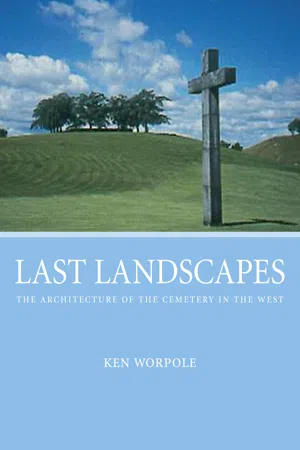![]()
References
INTRODUCTION
1 Lewis Mumford, The City in History (Harmondsworth, 1966), p. 18.
2 This phrase appeared in a review by Peter Stothard (Times Literary Supplement, 27 September 2002) of a biography of the British politician William Whitelaw; Stothard has kindly confirmed in a personal communication that the coinage is his.
3 Cited in Sarah Tarlow, Bereavement and Commemoration: An Archaeology of Mortality (Oxford, 1999), p. 6.
4 See Mario Erasmo, ‘Among the Dead in Ancient Rome’, Mortality, VI/1 (2001), which deals with this morphological aberration.
5 I am aware that James Stevens Curl, whose expertise in historical funerary matters exceeds most others, still insists on ‘mausolea’ as the correct plural form of mausoleum. In this instance, I prefer the vernacular ‘mausoleums’. The New Shorter Oxford Dictionary allows both.
6 James E. Young, The Texture of Memory: Holocaust Memorials and Memory (New Haven, MA, 1993), p. 3.
7 Christopher Daniell, Death and Burial in Medieval England 1066 – 1550 (London, 1998), p. 109.
8 Clifford Geertz, ‘Blurred Genres: The Refiguration of Social Thought’, in Local Knowledge (London, 1993), p. 19.
9 James Stevens Curl, The Victorian Celebration of Death (Stroud, 2000), p. 25.
10 James Stevens Curl, ‘Nunhead Cemetery’, private research paper, undated.
11 This citation was most recently cited by Dr Ian Hussein on becoming President of the Institute of Burial and Cremation Administration (IBCA) in 2001. See City of London Cemetery and Crematorium Newsletter, 6 (Winter 2001/2002), p. 8.
12 Edwin Heathcote’s fine book, Monument Builders: Modern Architecture and Death, Chichester, 1999), details some important twentieth-century architectural achievements in former East European countries. Likewise, Folk Art in Hungarian Cemeteries by Corvina Kiadó and Ernö Kunt (Budapest, 1983) offers a rich glimpse of a distinctive aesthetic at work, which ought to be more widely known and investigated.
13 One writer who records an occasional sense of sadness, if not despair, caused by the nature of the subject-matter is Sarah Tarlow in Bereavement and Commemoration. She rightly distinguishes between dealing with the subject in general, which is usually without any deep existential problems, and the very different matter of making a close study of individual epitaphs, inscriptions, personal outpourings of grief on the loss of children and other loved ones. In the case of the last mentioned, she recorded an occasional but nevertheless real challenge to her own emotional well-being.
ONE: LIVING WITH THE DEAD
1 Regina Barreca, ‘Writing as Voodoo’, in Sarah Webster Goodwin and Elizabeth Bronfen, eds, Death and Representation (Baltimore, 1993), p. 174.
2 Cited in Lindsay Prior, The Social Organisation of Death: Medical Discourses and Social Practices in Belfast (London, 1989), p. 111. This is an extraordinarily good book, a closely observed sociological study of all aspects of dying, death and funerary culture in contemporary Northern Ireland.
3 Françoise Dastur, Death: An Essay on Finitude (London, 1996), p. 5.
4 I am indebted to the ideas and suggestions of Richard Hill on many counts, but in this particular instance to his discussion of ‘Aesthetic Experience’ in Chapter 4 of Designs and their Consequences (London, 1999), pp. 87–108.
5 Dr Tony Walter, ‘Ritualising Death in a Consumer Society’, RSA Journal (April 1996), p. 36
6 Christopher Tilley, Metaphor and Material Culture (Oxford, 1999), especially pp. 177–84.
7 Howard Colvin, Architecture and the After-Life (London, 1991), p. 1.
8 Gaston Bachelard, The Poetics of Space (Boston, MA, 1994), p. 88.
9 Hilary Lees, English Churchyard Memorials (Stroud, 2000), p. 20.
10 Brian Bailey, Churchyards of England and Wales (London, 1987), p. 21.
11 Heinrich Härke, ‘Cemeteries as Places of Power’, in Topographies of Power in the Middle Ages, ed. Mayke de Jong and Frans Theuws, with Carine van Rhijn (Leiden, 2001), p. 20.
12 David Charles Sloane, The Last Great Necessity: Cemeteries in American History (Baltimore and London, 1995), p. 14. This excellent book sensitively and carefully delineates the very different attitudes towards death, burial and landscape that emerged in North America, in comparison with Europe, and which even today continue to develop in quite different directions.
13 The ideas of Yi-Fu Tuan are especially important to this book, especially those contained in Yi-Fu Tuan, Space and Place: The Perspective of Experience (London, 1977).
14 Christopher Tilley, Metaphor and Material Culture (Oxford, 1999), p. 181.
15 The reference to Malinowski’s views and their implications is suggested by Tony Walter, ‘Sociologists Never Die: British Sociologists and Death’, in David Clark, ed., The Sociology of Death (Oxford, 1993), p. 273.
16 Mary Douglas, Purity and Danger: An Analysis of the Concepts of Pollution and Taboo (London, 1984), p. 39.
17 Françoise Dastur, Death: An Essay on Finitude, trans. John Llewelyn (London, 1996), p. 39.
18 W. G. Sebald, Austerlitz, trans. Anthea Bell (London, 2001).
19 W. G. Hoskins, The Making of the English Landscape (London, 1977), p. 12.
20 The Newham figure is contained in Burial Space Needs in London (London Planning Advisory Committee, 1997), p. 54. The Boston figure is cited in Anne Whiston Spirn, The Granite Garden: Urban Nature and Human Design (New York, 1984), p. 219.
21 Phil...
